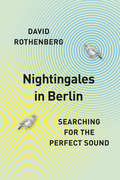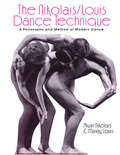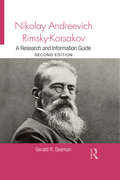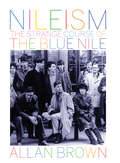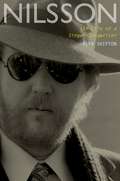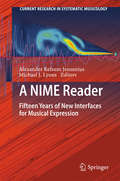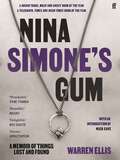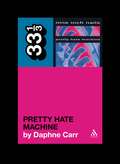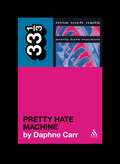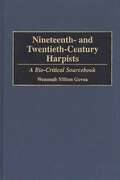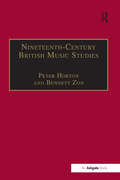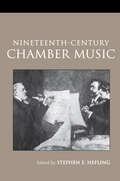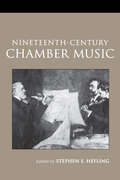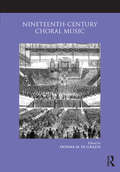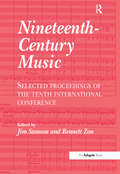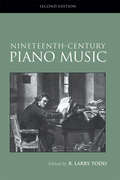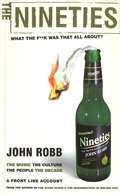- Table View
- List View
Nightingales in Berlin: Searching for the Perfect Sound
by David RothenbergA celebrated figure in myth, song, and story, the nightingale has captivated the imagination for millennia, its complex song evoking a prism of human emotions,—from melancholy to joy, from the fear of death to the immortality of art. But have you ever listened closely to a nightingale’s song? It’s a strange and unsettling sort of composition—an eclectic assortment of chirps, whirs, trills, clicks, whistles, twitters, and gurgles. At times it is mellifluous, at others downright guttural. It is a rhythmic assault, always eluding capture. What happens if you decide to join in? As philosopher and musician David Rothenberg shows in this searching and personal new book, the nightingale’s song is so peculiar in part because it reflects our own cacophony back at us. As vocal learners, nightingales acquire their music through the world around them, singing amidst the sounds of humanity in all its contradictions of noise and beauty, hard machinery and soft melody. Rather than try to capture a sound not made for us to understand, Rothenberg seeks these musical creatures out, clarinet in tow, and makes a new sound with them. He takes us to the urban landscape of Berlin—longtime home to nightingale colonies where the birds sing ever louder in order to be heard—and invites us to listen in on their remarkable collaboration as birds and instruments riff off of each other’s sounds. Through dialogue, travel records, sonograms, tours of Berlin’s city parks, and musings on the place animal music occupies in our collective imagination, Rothenberg takes us on a quest for a new sonic alchemy, a music impossible for any one species to make alone. In the tradition of The Hidden Life of Trees and The Invention of Nature, Rothenberg has written a provocative and accessible book to attune us ever closer to the natural environment around us.
Nightingales in Berlin: Searching for the Perfect Sound
by David RothenbergA celebrated figure in myth, song, and story, the nightingale has captivated the imagination for millennia, its complex song evoking a prism of human emotions,—from melancholy to joy, from the fear of death to the immortality of art. But have you ever listened closely to a nightingale’s song? It’s a strange and unsettling sort of composition—an eclectic assortment of chirps, whirs, trills, clicks, whistles, twitters, and gurgles. At times it is mellifluous, at others downright guttural. It is a rhythmic assault, always eluding capture. What happens if you decide to join in? As philosopher and musician David Rothenberg shows in this searching and personal new book, the nightingale’s song is so peculiar in part because it reflects our own cacophony back at us. As vocal learners, nightingales acquire their music through the world around them, singing amidst the sounds of humanity in all its contradictions of noise and beauty, hard machinery and soft melody. Rather than try to capture a sound not made for us to understand, Rothenberg seeks these musical creatures out, clarinet in tow, and makes a new sound with them. He takes us to the urban landscape of Berlin—longtime home to nightingale colonies where the birds sing ever louder in order to be heard—and invites us to listen in on their remarkable collaboration as birds and instruments riff off of each other’s sounds. Through dialogue, travel records, sonograms, tours of Berlin’s city parks, and musings on the place animal music occupies in our collective imagination, Rothenberg takes us on a quest for a new sonic alchemy, a music impossible for any one species to make alone. In the tradition of The Hidden Life of Trees and The Invention of Nature, Rothenberg has written a provocative and accessible book to attune us ever closer to the natural environment around us.
The Nikolais/Louis Dance Technique: A Philosophy and Method of Modern Dance
by Murray Louis Alwin NikolaisFirst Published in 2005. Routledge is an imprint of Taylor & Francis, an informa company.
The Nikolais/Louis Dance Technique: A Philosophy and Method of Modern Dance
by Murray Louis Alwin NikolaisFirst Published in 2005. Routledge is an imprint of Taylor & Francis, an informa company.
Nikolay Andreevich Rimsky-Korsakov: A Research and Information Guide (Routledge Music Bibliographies)
by Gerald SeamanNikolay Andreevich Rimsky-Korsakov: A Research and Information Guide, Second Edition is an annotated bibliography of all substantial, relevant published resources relating to the Russian composer. First published in 1988, this revised and expanded volume incorporates new information about the composer appearing over the last two decades, including literary publications, articles and reviews. Other sections provide a brief biographical sketch, selective discography, chronology and list of Rimsky-Korsakov’s works.
Nikolay Andreevich Rimsky-Korsakov: A Research and Information Guide (Routledge Music Bibliographies)
by Gerald SeamanNikolay Andreevich Rimsky-Korsakov: A Research and Information Guide, Second Edition is an annotated bibliography of all substantial, relevant published resources relating to the Russian composer. First published in 1988, this revised and expanded volume incorporates new information about the composer appearing over the last two decades, including literary publications, articles and reviews. Other sections provide a brief biographical sketch, selective discography, chronology and list of Rimsky-Korsakov’s works.
Nileism: The Strange Course of the Blue Nile
by Allan BrownA book about the most emotionally articulate group to emerge from Glasgow by one of the city's most mischievously eloquent writers is cause for celebration' - The Herald 'A comprehensive and compelling read' - The List 'An insightful and enthralling peek into the world of one of the greatest acts of the modern era' - Evening Herald Ireland 2011 sees the 30th anniversary of The Blue Nile's first work together. Four albums - containing a total of just 33 songs - have followed since. Yet scarcity has served only to intensify love for the band's intensely romantic songs. Reclusive and enigmatic, The Blue Nile are one of modern music's greatest mysteries, as secretive about their plans and status as they are about their painstaking methods. For the first time Allan Brown, a fan from the time of the band's first album in 1983 and friend of the band's composer Paul Buchanan, gets behind the veil to analyse the band's agonisingly slow progress through personal memoir, critical study, access to unreleased recordings and encounters with those who have been central to the strange and elusive mythology of The Blue Nile.
Nilsson: The Life of a Singer-Songwriter
by Alyn ShiptonPaul McCartney and John Lennon described him as the Beatles' "favorite group," he won Grammy awards, wrote and recorded hit songs, and yet no figure in popular music is as much of a paradox, or as underrated, as Harry Nilsson. In this first ever full-length biography, Alyn Shipton traces Nilsson's life from his Brooklyn childhood to his Los Angeles adolescence and his gradual emergence as a uniquely talented singer-songwriter. With interviews from friends, family, and associates, and material drawn from an unfinished autobiography, Shipton probes beneath the enigma to discover the real Harry Nilsson. A major celebrity at a time when huge concerts and festivals were becoming the norm, Nilsson shunned live performance. His venue was the studio, his stage the dubbing booth, his greatest triumphs masterful examples of studio craft. He was a gifted composer of songs for a wide variety of performers, including the Ronettes, the Yardbirds, and the Monkees, yet Nilsson's own biggest hits were almost all written by other songwriters. He won two Grammy awards, in 1969 for "Everybody's Talkin'" (the theme song for Midnight Cowboy), and in 1972 for "Without You," had two top ten singles, numerous album successes, and wrote a number of songs--"Coconut" and "Jump into the Fire," to name just two--that still sound remarkably fresh and original today. He was once described by his producer Richard Perry as "the finest white male singer on the planet," but near the end of his life, Nilsson's career was marked by voice-damaging substance abuse and the infamous deaths of both Keith Moon and Mama Cass in his London flat. Drawing on exclusive access to Nilsson's papers, Alyn Shipton's biography offers readers an intimate portrait of a man who has seemed both famous and unknowable--until now.
Nilsson: The Life of a Singer-Songwriter
by Alyn ShiptonPaul McCartney and John Lennon described him as the Beatles' "favorite group," he won Grammy awards, wrote and recorded hit songs, and yet no figure in popular music is as much of a paradox, or as underrated, as Harry Nilsson. In this first ever full-length biography, Alyn Shipton traces Nilsson's life from his Brooklyn childhood to his Los Angeles adolescence and his gradual emergence as a uniquely talented singer-songwriter. With interviews from friends, family, and associates, and material drawn from an unfinished autobiography, Shipton probes beneath the enigma to discover the real Harry Nilsson. A major celebrity at a time when huge concerts and festivals were becoming the norm, Nilsson shunned live performance. His venue was the studio, his stage the dubbing booth, his greatest triumphs masterful examples of studio craft. He was a gifted composer of songs for a wide variety of performers, including the Ronettes, the Yardbirds, and the Monkees, yet Nilsson's own biggest hits were almost all written by other songwriters. He won two Grammy awards, in 1969 for "Everybody's Talkin'" (the theme song for Midnight Cowboy), and in 1972 for "Without You," had two top ten singles, numerous album successes, and wrote a number of songs--"Coconut" and "Jump into the Fire," to name just two--that still sound remarkably fresh and original today. He was once described by his producer Richard Perry as "the finest white male singer on the planet," but near the end of his life, Nilsson's career was marked by voice-damaging substance abuse and the infamous deaths of both Keith Moon and Mama Cass in his London flat. Drawing on exclusive access to Nilsson's papers, Alyn Shipton's biography offers readers an intimate portrait of a man who has seemed both famous and unknowable--until now.
A NIME Reader: Fifteen Years of New Interfaces for Musical Expression (Current Research in Systematic Musicology #3)
by Alexander Refsum Jensenius Michael J. LyonsWhat is a musical instrument? What are the musical instruments of the future? This anthology presents thirty papers selected from the fifteen year long history of the International Conference on New Interfaces for Musical Expression (NIME). NIME is a leading music technology conference, and an important venue for researchers and artists to present and discuss their explorations of musical instruments and technologies. Each of the papers is followed by commentaries written by the original authors and by leading experts. The volume covers important developments in the field, including the earliest reports of instruments like the reacTable, Overtone Violin, Pebblebox, and Plank. There are also numerous papers presenting new development platforms and technologies, as well as critical reflections, theoretical analyses and artistic experiences. The anthology is intended for newcomers who want to get an overview of recent advances in music technology. The historical traces, meta-discussions and reflections will also be of interest for longtime NIME participants. The book thus serves both as a survey of influential past work and as a starting point for new and exciting future developments.
Nina Simone's Gum: A Memoir of Things Lost and Found
by Warren EllisFrom award-winning musician and composer Warren Ellis comes the unexpected and inspiring story of a piece of chewing gum. Featuring an introduction from Nick Cave.'Warren has turned this memento, snatched from his idol's piano in a moment of rapture, into a genuine religious artefact.'NICK CAVE'In praise of meaning-rich relics and magical things. Totally heartwarming project.'MAX PORTER'A unique study of a fan's devotion, of transcendence and of the artistic vocation - it's got depth and great warmth. It's a beautiful piece of work.'KEVIN BARRYOn Thursday 1 July, 1999, Dr Nina Simone gave a rare performance as part of Nick Cave's Meltdown Festival. After the show, in a state of awe, Warren Ellis crept onto the stage, took Dr Simone's piece of chewed gum from the piano, wrapped it in her stage towel and put it in a Tower Records bag. The gum remained with him for twenty years; a sacred totem, his creative muse, growing in significance with every passing year.In 2019, Cave - his collaborator and great friend - asked Warren if there was anything he could contribute to display in his Stranger Than Kindness exhibition. Warren realised the time had come to release the gum. Together they agreed it should be housed in a glass case like a holy relic. Worrying the gum would be damaged or lost, Warren decided to first have it cast in silver and gold, sparking a chain of events that no one could have predicted, one that would take him back to his childhood and his relationship to found objects.Nina Simone's Gum is about how something so small can form beautiful connections between people. It is a story about the meaning we place on things, on experiences, and how they become imbued with spirituality. It is a celebration of artistic process, friendship, understanding and love.
Nine Inch Nails' Pretty Hate Machine (33 1/3)
by Daphne CarrWhat is the world that Nine Inch Nails made, and what was the world that made Nine Inch Nails? These are the questions at the heart of this study of the band's 1989 debut, Pretty Hate Machine. The album began as after-hours demos by mercenary new wave keyboardist Trent Reznor, and was disciplined into sparse industrial dance by a handful of the UK's best industrial producers. Carr traces how the album became beloved in the underground, found its mass at Lollapalooza, and its market at the newly opened mall store Hot Topic. For fans, Nine Inch Nails was a vehicle for questioning God, society, the family, sex, and the body. In ten raw, heartbreaking oral histories woven through the book, fans living in the post-industrial Midwest discuss the successes and failures of the American dream as they are articulated in Nine Inch Nails' music. Daphne Carr illuminates Pretty Hate Machine as at once singular and as representative of how popular music can impact history and change lives.
Nine Inch Nails' Pretty Hate Machine (33 1/3)
by Daphne CarrWhat is the world that Nine Inch Nails made, and what was the world that made Nine Inch Nails? These are the questions at the heart of this study of the band's 1989 debut, Pretty Hate Machine. The album began as after-hours demos by mercenary new wave keyboardist Trent Reznor, and was disciplined into sparse industrial dance by a handful of the UK's best industrial producers. Carr traces how the album became beloved in the underground, found its mass at Lollapalooza, and its market at the newly opened mall store Hot Topic. For fans, Nine Inch Nails was a vehicle for questioning God, society, the family, sex, and the body. In ten raw, heartbreaking oral histories woven through the book, fans living in the post-industrial Midwest discuss the successes and failures of the American dream as they are articulated in Nine Inch Nails' music. Daphne Carr illuminates Pretty Hate Machine as at once singular and as representative of how popular music can impact history and change lives.
Nineteenth- and Twentieth-Century Harpists: A Bio-Critical Sourcebook (Bio-Critical Sourcebooks on Musical Performance)
by Wenonah M. GoveaThe harp is both the oldest and the newest of instruments. It has existed in some form in nearly all cultures since man has made music. The contemporary concert instrument has been known since the mid-19th century. This work is a compendium of the biographies of many notable harpists of the modern era. The biographies make clear how these performers shaped the contrasts in style and technique of harp playing that have developed over the past 150 years, as cultural, social, and psychological forces influenced individual performance. In addition to the biographical information, the A-Z entries include critical reviews, discographies, and selected bibliographies where possible. New material from the former Soviet states is included.
Nineteenth-Century British Music Studies: Volume 3
by Peter HortonSelected from papers given at the third biennial conference on Music in Nineteenth-Century Britain, this volume, in common with its two predecessors, reflects the interdisciplinary character of the topic. The introductory essay by Julian Rushton foregrounds some of the questions that are key to this area of study: what is the nineteenth century? what is British music? and did London influence the continent? The essays which follow are divided into broad thematic groups covering aspects of gender, church music, national identity, and local and national institutions. This collection illustrates that while nineteenth-century British music studies is still in its infancy as a field of research, it is one that is burgeoning and contributing to our understanding of British social and cultural life of the period.
Nineteenth-Century British Music Studies: Volume 3
by Peter HortonSelected from papers given at the third biennial conference on Music in Nineteenth-Century Britain, this volume, in common with its two predecessors, reflects the interdisciplinary character of the topic. The introductory essay by Julian Rushton foregrounds some of the questions that are key to this area of study: what is the nineteenth century? what is British music? and did London influence the continent? The essays which follow are divided into broad thematic groups covering aspects of gender, church music, national identity, and local and national institutions. This collection illustrates that while nineteenth-century British music studies is still in its infancy as a field of research, it is one that is burgeoning and contributing to our understanding of British social and cultural life of the period.
Nineteenth-Century Chamber Music
by Stephen HeflingFirst Published in 2004. Routledge is an imprint of Taylor & Francis, an informa company.
Nineteenth-Century Chamber Music
by Stephen HeflingFirst Published in 2004. Routledge is an imprint of Taylor & Francis, an informa company.
Nineteenth-Century Choral Music
by Donna M. Di GraziaNineteenth-Century Choral Music is an in-depth examination of the rich repertoire of choral music and the cultural phenomenon of choral music making throughout the period. The book is divided into three main sections. The first details the attraction to choral singing and the ways it was linked to different parts of society, and to the role of choral voices in the two principal large-scale genres of the period: the symphony and opera. A second section highlights ten choral-orchestral masterworks that are a central part of the repertoire. The final section presents overview and focus chapters covering composers, repertoire (both small and larger works), and performance life in an historical context from over a dozen regions of the world: Britain and Ireland, the Czech Republic, France, Germany, Hungary, Italy, Latin America, the Philippines, Poland, Russia, Scandinavia and Finland, Spain, and the United States. This diverse collection of essays brings together the work of 25 authors, many of whom have devoted much of their scholarly lives to the composers and music discussed, giving the reader a lively and unique perspective on this significant part of nineteenth-century musical life.
Nineteenth-Century Choral Music
by Donna M. Di GraziaNineteenth-Century Choral Music is an in-depth examination of the rich repertoire of choral music and the cultural phenomenon of choral music making throughout the period. The book is divided into three main sections. The first details the attraction to choral singing and the ways it was linked to different parts of society, and to the role of choral voices in the two principal large-scale genres of the period: the symphony and opera. A second section highlights ten choral-orchestral masterworks that are a central part of the repertoire. The final section presents overview and focus chapters covering composers, repertoire (both small and larger works), and performance life in an historical context from over a dozen regions of the world: Britain and Ireland, the Czech Republic, France, Germany, Hungary, Italy, Latin America, the Philippines, Poland, Russia, Scandinavia and Finland, Spain, and the United States. This diverse collection of essays brings together the work of 25 authors, many of whom have devoted much of their scholarly lives to the composers and music discussed, giving the reader a lively and unique perspective on this significant part of nineteenth-century musical life.
Nineteenth-Century Music: Selected Proceedings of the Tenth International Conference
by Jim SamsonThis selection of essays represents a wide cross-section of the papers given at the Tenth International Conference on Nineteenth-Century Music held at the University of Bristol in 1998. Sections include thematic groupings of work on musical meaning, Wagner, Liszt, musical culture in France, music and nation, and women and music.
Nineteenth-Century Music: Selected Proceedings of the Tenth International Conference
by Jim Samson Bennett ZonThis selection of essays represents a wide cross-section of the papers given at the Tenth International Conference on Nineteenth-Century Music held at the University of Bristol in 1998. Sections include thematic groupings of work on musical meaning, Wagner, Liszt, musical culture in France, music and nation, and women and music.
Nineteenth-Century Piano Music
by R. Larry ToddFirst Published in 2004. Routledge is an imprint of Taylor & Francis, an informa company.
Nineteenth-Century Piano Music
by R. Larry ToddFirst Published in 2004. Routledge is an imprint of Taylor & Francis, an informa company.
The Nineties: What the F**ck Was That All About?
by John RobbIF YOU REMEMBER THE NINETIES...YOU WERE THERE!The Rock 'N' Roll Fifties. The Swinging Sixties. The trashy Seventies. The money-grabbing Eighties. There is a neat bunch of clichés for every era, but THE NINETIES...What the f**k was that all about?John Robb takes us on a personal odyssey through the definitive pop cultural moments that shaped the decade in the UK.
